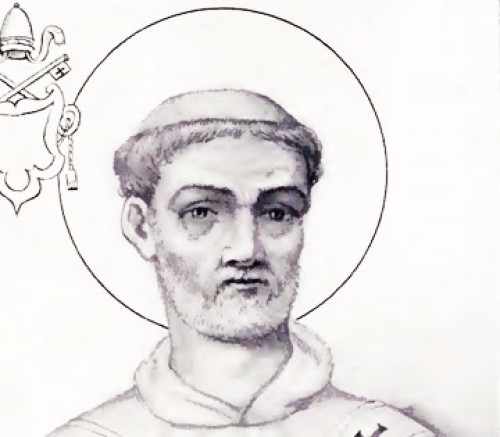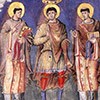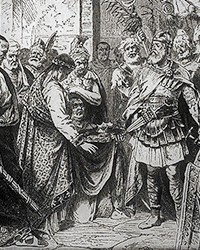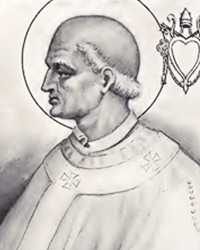
Coin with an image of Theodoric, Museo Nazionale Romano, Palazzo Massimo alle Terme

Pope Gelasius I, The Lives and Times of the Popes, Chevalier-Artaud de Montor, pic. Wikipedia

Pope Gelasis I, the Nuremberg Chronicle, 1493 r., pic. Wikipedia

Charles the bald with Popes Gelasisus I. and Gregory I from the sacramentary of Charles the bald, pic. Wikipedia

Pope Gelasius I, Le vite dei pontifici, 1710, Bartolomeo Platina
The Catholic Church considers him, along with Leo I, one of the most prominent popes of the V century and venerates him as a saint. Gelasius most likely came from Africa and was an advisor to previous popes: Simplicius and Felix III as well as a continuator of their uncompromising policy towards the doctrines which were considered unorthodox (meaning wrong), of Arianism, Pelagianism and Manichaeism. The leading motif of his four-year long pontificate was not only the defense of the Christological formula, proposed by Leo I at the Council of Chalcedon (451), but also the strengthening of the primacy of the Roman Church and of the pope in the Christian world.
The Catholic Church considers him, along with Leo I, one of the most prominent popes of the V century and venerates him as a saint. Gelasius most likely came from Africa and was an advisor to previous popes: Simplicius and Felix III as well as a continuator of their uncompromising policy towards the doctrines which were considered unorthodox (meaning wrong), of Arianism, Pelagianism and Manichaeism. The leading motif of his four-year long pontificate was not only the defense of the Christological formula, proposed by Leo I at the Council of Chalcedon (451), but also the strengthening of the primacy of the Roman Church and of the pope in the Christian world.
In the conflict with the Eastern Church and the Eastern Roman Empire, which was overshadowed by the schism lasting from the times of Felix III, Gelasius was uncompromising. After assuming the mantle of the Bishop of Rome, he did not send the customary note to the Emperor of the Eastern Roman Empire, requesting to be confirmed, and after the protest of Emperor Anastasius I, he send him a letter explaining his own doctrine of a diarchy (494), meaning the division of imperial and papal rule, which resulted in a long-lasting war between the Church and state. According to Gelasius the two authorities are independent of each other, but the spiritual one – due to the four last things – is superior. In his letter to the emperor he put it in such words: „There are two powers, august Emperor, by which this world is chiefly ruled, namely, the sacred authority of the priests and the royal power. Of these, that of the priests is the more weighty, since they have to render an account for even the kings of men in the divine judgment.” A year later Gelasius, for the first time in history, referred to himself as not only the successor of St. Peter, but also as the Vicar of Christ on Earth, underlining thus the primacy of the Holy See (Rome) in the rule over the Christian world.
When it comes to Rome, Gelasius exhibited far reaching pragmatism. He maintained good relations with the ruler of Italy and the successor to Odoacer – Theoderic the Great, who himself was a follower of Arianism. In time of a famine in the city, he was able to encourage the ruler to financially help the needy, while the pope himself also assigned rather large sums to the cause from the treasury of the Church. He also encouraged the clergy to give one-fourth of their income to the poor.
He will be remembered as the first pope in history to put into effect the dogma proposed by his predecessor (Felix III) refusing unbaptized children the possibility to attain salvation. This was in reality a battle against Pelagianism, whose followers believed that the original sin itself cannot be condemned. Yet, for centuries the Catholic Church was convinced that original sin of newborns excludes them from salvation and can only be washed away through baptism. It was not until 2007 when Pope Benedict XVI changed this view. An International Theological Commission called by him, announced after two years of debate, that “there are theological and liturgical reasons to hope that infants who die without baptism may be saved and brought into eternal happiness.”
In a different manner Gelasius battled against Manicheans. In order to identify them, he ordered the faithful to accept the Eucharist in two forms – bread and wine. Those who refrained from the wine, were accused to be opposed to the doctrine of the Roman Church.
Gelasius I was made famous as the final conqueror of the still practiced, popular among Romans, pagan Lupercalia – the last ancient Roman celebration of fertility and purification. On the day it was celebrated (February 2nd) he introduced a Catholic Feast of the Purification of the Blessed Virgin Mary (Candlemas).
He was buried in the vestibule of the old Basilica of St. Peter (San Pietro in Vaticano). After the church’s reconstruction all traces of his tomb vanished.


















